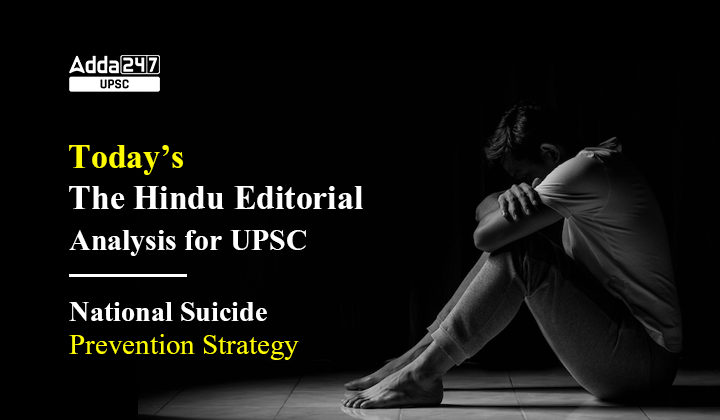Table of Contents
Significance of National Suicide Prevention Strategy for UPSC
Under UPSC CSE Mains Syllabus, The National Suicide Prevention Strategy covers GS Paper 1: Population and Associated Issues, GS Paper 2: Government Policies & Interventions & Health.
Why National Suicide Prevention Strategy is in news?
- Recently, the Ministry of Health and Family Welfare, Government of India, published National Suicide Prevention Strategy.
- It has been a long time coming, but the Strategy, finally in the public realm, calls attention to the massive burden of suicides in the country.
Also Read: The Geo-heritage Value of Ram Setu- The Hindu Editorial Analysis
What are the goals to be achieved through ”National Suicide Prevention Strategy”?
- National Suicide Prevention Strategy is the first of its kind in the country, with time-bound action plans and multi-sectoral collaborations to achieve reduction in suicide mortality by 10% by 2030.
- The strategy is in line with the World Health Organisation’s South East-Asia Region Strategy for suicide prevention.
- At the same time, it has measured the paces forward with a timebound action plan that takes into account the grim realities of a varying ground situation in India.
- Importantly, the document notes that contrary to belief, the majority of suicides are preventable.
Also Read: COP27 to Create a Special Loss and Damage Fund | Today’s The Hindu Editorial Analysis for UPSC
What are the most common reasons of suicide?
- The most common reasons include family problems and illnesses, while other causes include marital conflicts, love affairs, bankruptcy, substance abuse and dependence.
- Further, in approximately 10% of cases, the cause for suicide remains unknown.
How Suicide is a Global Problem?
What WHO’s data says?
- Globally, suicide is the second leading cause of death among 15-29 year olds and also the second leading cause of death for females aged 15-19 years, as per WHO estimates.
What NCRB’s data says?
- In India, more than one lakh lives are lost every year to suicide.
- In the past three years, the suicide rate has increased from 10.2 to 11.3 per 1,00,000 population.
- As per National Crime Records Bureau statistics, Maharashtra, Tamil Nadu, Madhya Pradesh, West Bengal and Karnataka have the highest percentage share of suicides (2018-2020), ranging between 8% to 11%.
Also Read: Issues with Political Financing in India | Today’s The Hindu Editorial Analysis for UPSC
What are the key provisions of National Suicide Prevention Strategy?
- The National Suicide Prevention Strategy is etched with evidence based practices to reduce the number of suicides, inspired by WHO’s strategy for the South East Asian region, and strings together multiple sectoral collaborations to provide a cohesive strategy and achieve the intended reduction in the number of suicides.
- In addition to committing to establishing effective surveillance mechanisms within the next three years, and psychiatric outpatient departments in all districts over five years, the Strategy also intends to write in mental health in the curriculum in educational institutions within the next eight years.
- Addressing issues relevant to India, including access to pesticides, and alcoholism, has set the Strategy on the path towards achievement of the goals.

Way forward
- The best first step towards addressing a malaise is to recognize that it exists, which is rightly done by the government, recognizing suicide a serious problem.
- However, more need to be done at the level of states to achieve a reduction in suicide mortality by 10% by 2030, as in a federal country like India, any success is possible only if States are enthusiastic participants in the roll out.
- The problem is indeed dire, and without targeted intervention programmes, and stigma reduction strategies, a public health crisis of gargantuan proportions is imminent.
Also Read: The Editorial Analysis: Does India Need a Population Policy?



 TSPSC Group 1 Question Paper 2024, Downl...
TSPSC Group 1 Question Paper 2024, Downl...
 TSPSC Group 1 Answer key 2024 Out, Downl...
TSPSC Group 1 Answer key 2024 Out, Downl...
 UPSC Prelims 2024 Question Paper, Downlo...
UPSC Prelims 2024 Question Paper, Downlo...





